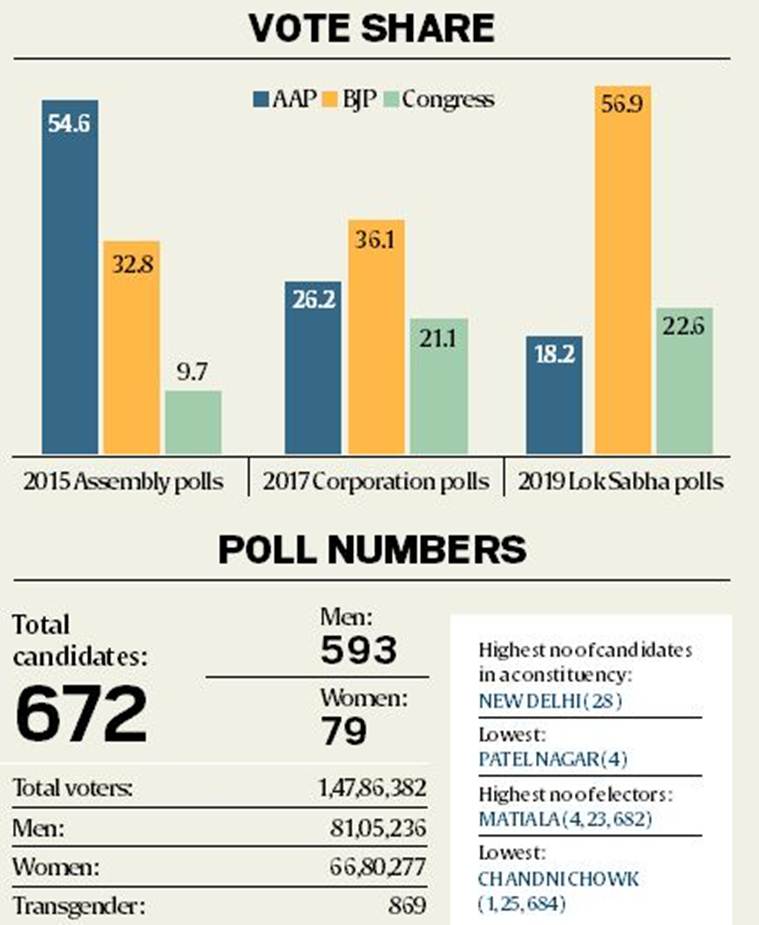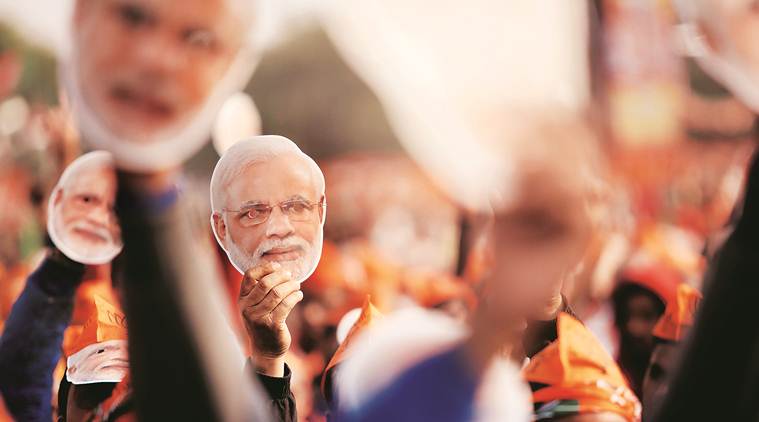Much more than 70 seats are at stake in the Delhi Assembly polls that just ended. For AAP, the Feb 11 results will show if its gambit of seeking a mandate on its performance has paid off; for BJP, if Modi name, Hindutva agenda prove stronger than CAA anger.
Prime Minister Narendra Modi’s Vijay Sankalp rally in Dwarka on Feb 4. (Express Photo by Praveen Khanna)
The last time the BJP had a government in Delhi, Red Line buses with their ‘killer’ tag were still the norm, there was no Metro in Delhi, and the year was 1998.
In 2013, the party thought its political vanvaas from the Capital, and all it implied in terms of its optics, was about to end, with the Congress fighting 15 years of anti-incumbency, nursing wounds from the Lok Sabha election battering earlier that year, and its much-liked CM Sheila Dikshit ailing and sidelined.
What followed was a rarity in Indian elections — especially Delhi, where polls have always been a Congress vs BJP stage. The fledgling Aam Aadmi Party, born just a year earlier from an anti-corruption movement, sneaked past both the parties, winning 28 out of 70 seats. The Congress, that had taken the brunt of the AAP’s attack in the run-up to the polls, lent it support to keep the BJP out. When that government fell within 49 days, as Chief Minister Arvind Kejriwal resigned in what the party said was a “principled decision” over the Delhi Assembly not passing the Jan Lokpal Bill, AAP returned to power in February 2015 with an astounding 67 seats.
A two-way contest
Much water has flowed under the bridge since. The BJP won all the seven seats in the 2019 Lok Sabha elections in Delhi, the AAP’s national ambitions have had a reality check, and the Congress is out of the picture even after having fallen back on Dikshit’s legacy in a desperate bid to save its face. However, there is another change, slow but steady, that makes this a battle that could decide the country’s politics. The AAP has dug its heels in, seeking to make the Capital campaign about performance, and showcasing its undeniable work in the field of education and health. The BJP is no longer talking of vikas but, to uproot 51-year-old Kejriwal, has resorted to its time-tested Hindutva strategy, with the added sting of the contentious Citizenship (Amendment) Act, led by a battery of top leaders.
The February 11 results may well decide which of those two strands wins out — and which is adopted by the two parties and others going forward.

AAP: Kejriwal all the way
It tried out several slogans — from ‘Achhe beete paanch saal, lage raho Kejriwal’, to ‘Mera vote AAP ko, seedha Kejriwal ko’, and ‘Achhe honge paanch saal, Dilli main toh Kejriwal’. But each only underlined that for AAP, the USP remains CM Kejriwal.
Ram Kirpal Singh, 47, a resident of Govindpuri, whose house is barely 500 metres from the office of AAP candidate Atishi, herself a visible party face, says he doesn’t really care about the nominee. “A woman is contesting this time. I don’t remember her name, but it doesn’t matter. We are voting for Kejriwal,” he says.
Always the party’s face, having forged it out of an anti-corruption movement with Anna Hazare, Kejriwal is now its undisputed leader. This is partly because of the series of fallouts with other AAP leaders. Between 2012 and 2017, among senior leaders to leave AAP were Prashant Bhushan and Yogendra Yadav, once the top three in the party with Kejriwal. Kumar Vishwas is virtually out too though he remains in the party’s highest decision-making body, the Political Affairs Committee.
His detractors have alleged Kejriwal works like a “dictator”. “He told people they were where they were because of him. When he is angry, he is extremely harsh,” says a party member, not wishing to be named, though adding that Kejriwal was not entirely wrong. “It is because of him that unknown people who would have never joined politics or stood a chance at winning were sent to the Vidhan Sabha.”
It is this promise that AAP still holds, despite five years in power, that lies at the centre of its appeal. Those looking for an alternative to the BJP, including earlier Congress voters, continue to stand with AAP. While the Congress had showed a brief blink in the 2019 Lok Sabha polls, finishing ahead of AAP in the vote share, it is seen to have decisively lost its core support base of unauthorised colonies and jhuggi-jhopdi clusters to AAP.
Over the past year, AAP assiduously worked on road construction and sewer-laying projects in uanuthorised colonies, consolidating their support. The Supreme Court decision that gave the government more autonomy also helped the party come out with policies aimed at the lower middle class, such as the power subsidy and free bus ride for women, as it tried to put the 2019 setback behind.
AAP also designed a campaign markedly different from 2015. Where Kejriwal addressed rallies and nukkad sabhas last time, the focus now was on policy and governance-related issues through townhalls on TV channels and road shows, where he did not speak. Between April and December, Kejriwal addressed at least one press conference every two weeks.
Says AAP campaign director Pankaj Gupta, “In 2015, we did not have a lot of work to show. This time, our pitch was work and the campaign bore that stamp.”
Roping in I-PAC’s Prashant Kishor helped the party put more feet on the ground, especially at a time when the BJP brought ground-level volunteers to Delhi from other states. Kishor’s team helped AAP plan a more direct messaging strategy of keeping Kejriwal at the forefront.
Party members believe they started out strong in December. Says a senior leader, “We were in control of the narrative well into December, before the polls were announced.”
The BJP stepping up its game since then, and making it about the CAA, is the reason there is a whiff of uncertainty now about what will happen come February 11. Admits the party leader, “We knew the BJP would try something, but hadn’t expected this blitzkrieg. When we conducted internal polls in December, people barely discussed the BJP. Only the core voters said they would vote for the party since they had always done that.”
As the BJP kept raising questions about the anti-CAA protests, making it a nationalists vs traitors debate, even accused Kejriwal of being a terrorist, the AAP tried not to be drawn in and to stay on message.
In an interview to The Indian Express, the CM said the BJP was raising Shaheen Bagh as it had no work to show, including in the Delhi municipal corporations it has governed for over 12 years.
Several party leaders, including Kejriwal, say AAP has created a new idiom for voters, giving them the option of choosing work over everything else. “It is a new kind of politics of schools, hospitals, power and water. No one has ever spoken about it,” Kejriwal told The Indian Express in his interview.
Sensing a negative reaction from majority voters over Shaheen Bagh, AAP leaders took a conscious decision to not be seen supporting the agitation. Kejriwal said repeatedly that people have the right to protest but not cause inconvenience, exhorting the Delhi Police, that comes under the Centre, to remove the protesters.
But, with Kejriwal also casually underlining his Hindu belief, there has been criticism over this silence. Defending this, a senior AAP leader says, “We can’t fight on the BJP’s turf of communal politics and we combated it our own way. The party is working on bringing out a more human, personal face of Kejriwal, and that includes details about his religion and his personal conduct. It is very different from how the BJP pitches itself.”
Having promised to be actually a party with a difference, AAP has also been accused of going the way of other parties and taking in hundreds of leaders professing a different politics, including from the BJP, Congress, JD(U) and BSP. Nine people given tickets this time had joined AAP only a few hours or days before.
Says the AAP leader, “When you bring in people like Shoaib Iqbal, (who was earlier an MLA from Congress and JD-U), and Vinay Mishra (son of former West Delhi MP from Congress, Mahabal Mishra), to expect they will remain with AAP if the party loses is naive. I don’t believe anyone in the party thinks so either, but the stakes are so high that winnability was a key factor in distributing tickets.”
As the result day approaches, the biggest fear that plagues a Kejriwal-centric AAP is can it remain together in the face of a loss. The Punjab example is not very encouraging. Having emerged as the main Opposition party there fighting its first Assembly election in the state, as well as getting four Lok Sabha seats in 2014, AAP crumbled in the state under a series of splits.
Party leaders admit that this is the toughest election they have faced — more than 2013 or 2015, with the novelty factor having evaporated under the harsh light of five years in power.
Sanjay Kumar, political analyst and director, Centre for the Study of Developing Societies (CSDS), says AAP can’t afford a loss. “Losing would mean end of the party. Slowly, the party will start disintegrating,” he warns.
But with Deputy CM Manish Sisodia standing steadfast by Kejriwal, party leaders say that no matter what his detractors might say, he is the only leader with the dexterity to keep AAP together.
“It’s simple. Without him, there is no reason for many people to stay in the party,” says a 28-year-old volunteer.
BJP: CAA on lips, eye on Bihar
Addressing booth-level BJP workers at a packed IGI Stadium in New Delhi on January 5, a month before the Assembly polls, Home Minister Amit Shah cautioned them not to be over-dependent on big rallies but go door-to-door. Later that evening, at one such small meeting in Lajpat Nagar, Shah himself distributed pamphlets in support of the Citizenship (Amendment) Act.
What was lost in the small print the next day was the sign that Shah, the BJP’s poll trump card, was set to take over charge of another tough electoral battle for the party. In the days that followed, the BJP would hold 6,577 public meetings, including road shows, 52 by Shah, 41 by national president J P Nadda, 12 by Defence Minister Rajnath Singh, and many others by the party’s 200 MPs and 50 current and former ministers as it rolled out its heavy artillery against a resurgent Aam Aadmi Party.
In contrast, in the 2015 Assembly elections, Shah had held three-four big rallies and six to seven workers’ meetings in Delhi. BJP leader Praveen Shanker Kapoor, who oversaw that poll for the party, also lists other ministers and senior leaders who canvassed, like Ravi Shankar Prasad, Nirmala Sitharaman, Arun Jaitley and Ram Lal.
Still, there is no denying the scale of the BJP’s involvement now — apart from the shrillness of its campaign — indicating the importance for the party of Delhi, a half-state that sends just seven MPs to the Lok Sabha. The BJP has been out of power in Delhi now since 1998, and the February 8 elections came in the wake of several state poll setbacks. However, there is a bigger, overarching reason: the first polls after the CAA was passed, they are being seen by many as a mandate on the Act, amidst growing protests across the country.
With exit polls predicting an AAP win, BJP Rajya Sabha MP and national vice-president Vinay Sahasrabuddhe denies that what is at stake is the CAA. “A win in Delhi might underline that the silent majority supports the Act, but it was part of the BJP’s manifesto in 2019 too and the results then were already a kind of referendum on it,” he says. “It is not something we did one fine morning, there were enough deliberations (in Parliament).”
Asserting that they would win, BJP president Manoj Tiwari argues that it is AAP which stands to lose the most in case of a defeat. “For us, every election is different. For Kejriwal, it is a matter of do-or-die.”
But there are other reasons the results are important for the BJP. Many leaders admit in private that one reason the party won all the three Delhi corporations in 2017 was its sweep in the preceding Uttar Pradesh Assembly elections. This win came despite the BJP facing 10 years of anti-incumbency and accusations of corruption in the corporations.
A victory in Delhi now would mean the BJP will go into the Bihar polls with more bargaining power against partner JD(U). As per a survey by CSDS, the Purvanchali population from eastern India is dominant in about 16 of the Capital’s 70 Assembly seats. Making up over 30% of Delhi’s population, what they think in the Capital is expected to have ripples at their homes back in Bihar.
CSDS Director Sanjay Kumar says that should it win Delhi, the BJP could even attempt going it alone in Bihar. “They would want a situation where all the three parties (the BJP, RJD and JD-U) go alone in Bihar.”
A loss, on the other hand, he says, “means that the JD(U) will start flexing its muscles and demand more seats”.
Another BJP leader says that with AAP’s massive footprint in the state, a defeated BJP might not be able to retain its hold on the corporations either — by 2022, the party would be up against 15 years of anti-incumbency. One glaring omission is the failure of the Delhi civic bodies to improve infrastructure in its schools, even as AAP makes education the showpiece of its government, the continuing problems with sanitation and the failure to improve corporation budgets despite the purse-strings being with the Centre.
With the BJP going into the elections without a chief minister face, despite frequent taunts by AAP, a loss — after setbacks in Jharkhand, Maharashtra and a coalition government in Haryana — could underline the chink in the party’s armour of depending solely on Narendra Modi’s face to win. Its slogan for the Capital is ‘Dilli Chale Modi ke Saath’.
Tiwari, the Delhi BJP chief and one of the CM contenders, denies the other results mean much. “In Maharashtra we won but were backstabbed by our alliance partner, Haryana we won, Jharkhand too an alliance with the AJSU would have meant victory,” he says.
The CSDS’s Kumar too cautions against seeing a Kejriwal win as a setback for Modi. “There would be many who like Modi but would vote for Kejriwal in the state. They might not like Shaheen Bagh but would vote for AAP’s Mohalla Clinic.”
That could be one reason why Shah has shouldered the BJP’s campaign in Delhi, though a win coming from behind would go a long way towards erasing the perception that the Home Minister is more of a party manager than a campaigner. “I think they anticipate that Delhi might slip out of their hands so they strategically brought Shah to the forefront,” Kumar says.
In private, there is another source of wariness among BJP leaders, of the ripple effects an AAP win might send amidst an Opposition vacuum. “If Arvind Kejriwal wins a second term, he will change his strategy, again start abusing PM Modi and might even attempt to stitch a third front along with Prashant Kishor, who has good terms with several regional parties and has even worked with the Congress,” says a leader.
Apart from AAP, Kishor’s election management firm has earlier worked with CMs Amarinder Singh in Punjab, Nitish Kumar in Bihar, Y S R Jagan Mohan Reddy in Andhra Pradesh, Mamata Banerjee in West Bengal as well as Akhilesh Yadav in Uttar Pradesh. Recently, it struck a deal with the DMK, which is strongly placed for the next Tamil Nadu elections.
Swaraj India head Yogendra Yadav says that should the BJP win after spreading “poison” as it did in Delhi, “we are at a very tough time as a country”. “If they win, they will say people are endorsing their view on CAA, but if they lose, then the opposite will also be true, that people of Delhi refuse to see Shaheen Bagh as enemy.”



 At an AAP rally on Jan 20, before Arvind Kejriwal filed his nomination. (Express Photo by Praveen Khanna)
At an AAP rally on Jan 20, before Arvind Kejriwal filed his nomination. (Express Photo by Praveen Khanna)





1 Comments
Filtration performs 3 cleaning functions. It removes visible waste and debris from decaying plants to chips of driftwood. Bacterial Filtration Efficiency Tester
ReplyDelete